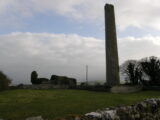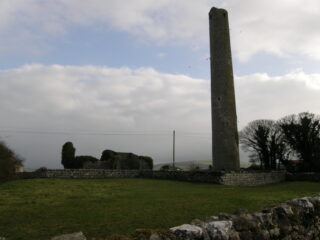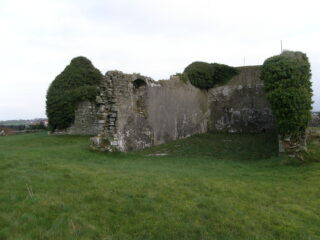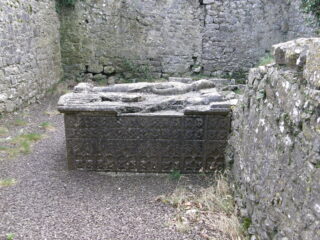Grangefertagh Round Tower and Church
Situated in an early Medieval monastery founded by St. Ciarán of Saigir
Unguided sitesNotice
Grangefertagh Round Tower and Church are state-owned National Monuments in the care of the Office of Public Works
*External View Only, Internal Access is Not Permitted*
WARNING: It should be noted that these sites are unguided and a level of care and caution should be maintained during all stages of your visit. The Office Of Public Works (OPW) will not be held responsible for any damages, injuries, or losses that occur
Grangefertagh Round Tower and Church
Set within an early medieval monastery founded by St. Ciarán of Saigir in the 6th century stands Grangefertagh Round Tower. The round tower has eight floors, is 31.5m tall and is built from limestone. A round tower within an ecclesiastical enclosure denoted the financial success of the monastery. Raids and plundering of monasteries by Vikings and the local Irish was common-place. The Annals of the Four Masters notes that this round tower was raided by Vikings in 861. Then in 1156, with the chief master/lector Eochaidh O’Cuim within the round tower, it was burned by the high king Murtagh McNeale. The original doorway, to the north-east, is 3.3m above ground and accessed originally by ladder, so too are the internal floors. Grangefertagh round tower has, in total, nine windows. Four triangular-headed bell-floor windows face the cardinal points, on the top storey. The remaining five windows, in the body of the tower in descending order, are two triangular-headed, two lintelled and two triangular-headed windows. From the tower’s cornice, a lower portion of the original conical capstone is still present.
Grangefertagh Church represents the evolution of the monastic site. This church was part of the priory founded in the 13th century on the site of St. Ciarán’s 6th century original monastery. The 13th century priory was founded by the Blanchfield family for the Canons Regular of St. Augustine. The priory is mentioned throughout the 13th, 14th and 15th centuries in the Calandar of Papal Registers. In the 15th century however the fortunes of the former 13th century monastic site was in decline. In 1421 it is noted that the religious order of Canons were left to wander and beg for food, such was the poor state of the priory. After the suppression of the priory, the site was held by Sir Edward Butler, and then his son in 1567. The priory church, with its east to west orientation, was built from limestone. Presently, the western end no longer survives. The southern side of the church led to a sacristy. In the north wall there is a two-light ogee-headed window. The north chapel, an extension onto the north wall, was built by the Mac Giolla Phádraig family in the 15th/16th century, and is known today as the Kilpatrick chapel. The effigial tomb within shows a knight and lady in high relief. The Latin inscription is translated as: ‘Here lie the former good lords of Ossory John Mac Gilla Patrick and Lord Brian his son. Upon whose souls may God have mercy. Here lies Katherine Molloy, mother of Brian the erector of this tomb’. The sides of the tomb show decorated tracery, lierne vaulting and foliate quatrefoils. The tomb was carved by Rory Tunney, who’s tomb carvings can also been seen at Jerpoint Abbey. A grave-slab dated to the 13th/14th century is nearby, and has, in raised relief, a four-armed trefoil-headed cross. The priory church was in use for Protestant service from the mid-16th century until the mid-18th century. The end of the priory church was in 1780, when its roof collapsed.
Visit Historic Environment Viewer for more information on Grangefertagh Round Tower and Church
Protect our Past - Click here to read about the importance of protecting our country’s unique heritage sites
This national monument is protected in accordance with the National Monuments Acts 1930 to 2014
Gallery
Nearby sites to visit
Famine Warhouse 1848
The unlikely site of a bloody skirmish
Approx. 17.8 km from Grangefertagh Round Tower and Church
Heywood Gardens
Discover a tranquil and romantic hillside landscape
Approx. 20.5 km from Grangefertagh Round Tower and Church
Dunmore Cave
A unique attraction where history and geology merge
Approx. 20.6 km from Grangefertagh Round Tower and Church
Kilkenny Castle
The jewel in the crown of an enchanting medieval city
Approx. 24.5 km from Grangefertagh Round Tower and Church
Roscrea Castle, Gardens and Damer House/Black Mills
A place of medieval might and eighteenth-century elegance
Approx. 26.0 km from Grangefertagh Round Tower and Church
Kells Priory
Visit Ireland’s largest enclosed ecclesiastical site
Approx. 32.7 km from Grangefertagh Round Tower and Church




